August 22nd, 2007
US version, $34.95
Softbound, 9 7/8 x 8 1/8 inches , 176 pages,
275 mainly color and B&W
Published by Veloce Publishing LTD, 33 Trinity Street, Dorchester, Dorset DT1 1TT, England
Telephone 01305 260068
ISBN: 978-1-84584-133-1
Order from Veloce Publishing
The title of this book could be �Great Small Fiats: Fiats under 1000cc but in some cases as much as 1300cc but not including the Balilla and depending on their charm as determined by Phil Ward.�
One could put away several hundred gallons of Guinness arguing about what great and small Fiats should be included in this book. The Great isn�t too bad, that can stand alone, to be defined by the author�s preferences. But Small? Small needs to be referenced and more clearly defined, a difficult task when dealing with Fiat product lines.
But that aside, why don�t we simply list the cars Ward so ably writes about.
500 (Topolino)
600
1100 103
Nuova 500
850
128
127
126
Panda
Uno
Cinquecento
Seicento
Nuova Panda
New 500
If the car you are looking for is not on this list, look no further. Don�t ask why, for that will lead to a dozen other questions and you will still be left with what is. �It is what it is and that�s all that it is!� to paraphrase Popeye.
There is nothing wrong with it, either. For Phil Ward, the editor of Auto Italia magazine, has composed a perfectly splendid book which presents material in a refreshing manner. Few could argue that he should start his journey with the 1936 500 �Topolino�. It was the product of both Dr. Antonio Fessia and Dante Giacosa, and turned the automotive world on its head. As a leading edge product of small car design. the Volkswagen was close but never made serious production until after the war. Everyone else was left in the dark ages, even the brilliant Balilla introduced only two years before. The Topolino would have had front wheel drive as well but for Agnelli himself, who had an accident in a front wheel drive car and would not allow his company to produce one.
Ward provides a brief background of the cars, the model changes (and in the back of the book, a complete spec sheet of every model covered in the book). In the case of most of the models, also included are driving impressions, restoration advice, racing or modified models, much of this material having been borrowed from the pages of Auto Italia. It is this combination of sources that makes the book so enjoyable. Some may take a dim view of modified, hot rodded Fiats, but such cars are an interesting diversion and part of our world of cars.
For better or worse (we keep trying to stay away from the selection criteria at the same time coming back to it) the Fiat 126 and 127 models were included, even though they have little character (ok, zero character) and no great legacy. They were, however, small and sold in great numbers.
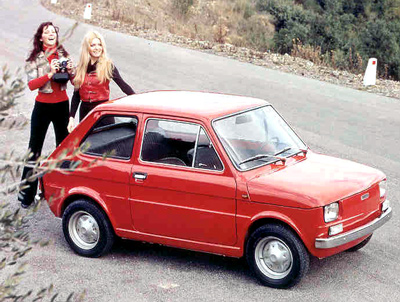
The Fiat 126 replaced the legendary 500, had a long life and was superior to the older 500. Photo courtesy Veloce Publishing.
|
The rear engined two cylinder 126 was, ironically, a far superior product than the 500 it replaced, but it lacked the �cheekiness� of the original 500. The new car was initially charged to Giacosa, but according to Ward, �Giacosa was nearing retirement so he was effectively a consultant to the project.� Built from 1972 to 1991, the air cooled two cylinder engine displacement increased from 594 cc to a water cooled 704 cc. The 127 was replaced by the Cinquecento.
Designed to replace the 850 line, the 127 was a combination of the 128, the 850, and the Autobianchi A112 from which it (and the 128) received front drive lessons. It had a for a long and profitable run; the front drive four cylinder 127 was built from 1971 to 1987, with a range of engine types which included both the Fiat Diesel and the long lived 903cc engine, itself derived from the Giacosa 600. In the mid 1970s, the 127 was the best selling car in Europe. Worthy of inclusion or not, we learned a lot from Ward�s in depth chapters on these cars.
Life was simple in the Giacosa era. How pleased and smart ass I was to know that I knew a 124 from a 125, an 1100S from a mere 1100 103, an 850 from a 600, and finally learned how to correctly spell Balilla. We, who have been deprived (if in fact deprived is the correct word) of Fiat products for roughly 35 years, (meaning most Americans, since Fiat stopped importing everything but the 124 and X1/9, in the mid-1970s.) have a lot to learn and much of it is in Ward�s book.
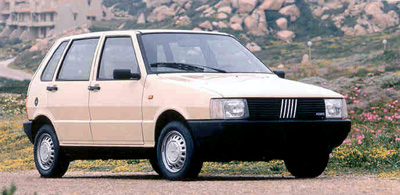
The Uno was another car which sold and sold and sold but was lacking in soul. Photo courtesy Veloce Publishing.
|
Fiats in the seventies and eighties were a mixture of past present, future cars all trying to keep up with increasing technologies and new government regulations regarding safety and emissions. Not an easy time and an era of great frustration which only began to be resolved by the late 1990s. From the surprisingly inspirational Panda to somewhat diffident Uno Fiat products sold well, did their job, but lacked heart and charisma. Perhaps the sub model names told the story best: The Young, the Young 2, Trekking, College, Hobby, Caf�, Bella, Dance, Fun, all to describe Panda model trim for specific markets.
With the Cinquecento and Seicento models, both introduced in the 1990s, Fiat finally started producing cars which not only looked forward, but looked good. Ward offers long chapters on both of cars. The Cinquecento and Seicent set the pace for the next century and even included battery powered models. No doubt hounded by the Japanese competition, both models were advanced, complex, rode well, performed well and reliably. Fiat even brought out the Abarth name again with a bit more honor this time around.
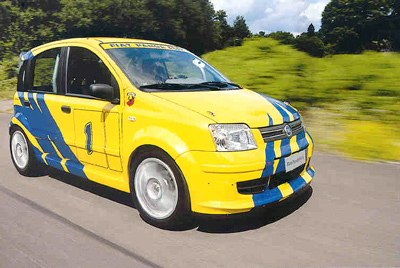
The Nuova Panda, introduced in 1999, was the basis for this Panda Abarth prototype track tested in Auto Italia magazine. Photo courtesy Veloce Publishing.
|
By the turn of the century one would have to deal with new alphabet of computer assisted driving; ABS, EBD, ESP, ASR, MSR and HBA, all part and parcel of the Nuova Panda and the New 500. Ward was able to sneak a look at the New 500 despite presstime constraints, and its inclusion brings the model section to a very nice ending.
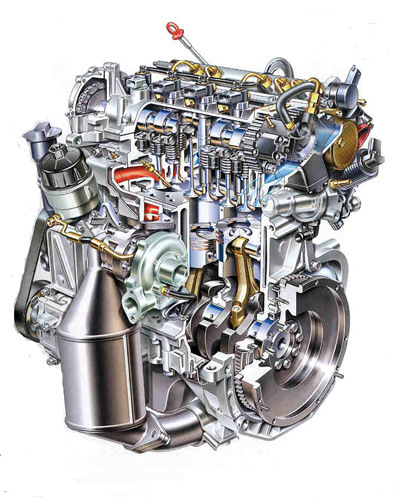
Fiat's 16 valve 70 hp 1300cc Multijet engine is rated to last 250,000 km and uses a chain vs the timing belt. Photo courtesy Veloce Publishing.
|
As Ward concentrates on the later models and options, he loses the friendly prose accorded to the Giacosa Fiats. Writing about each of the models in some detail requires some patience on the part of the author but it is literally required reading. informative, and present the material in a fashion which encourages use as a reference.
Ward�s descriptions of these later Fiats is quite, absolutely welcome. As he claimed, it doesn�t cover them all, some don�t fall under the heading of great or small, but we�ll take it anyway.
His enjoyable writing style is again apparent in the last chapters of the book. Here he gets away from the PR releases and writes about Autobianchi, an ancient Italian firm taken over by Fiat after WWII. By the mid fifties Autobianchi was producing upscale versions of the Fiat 500; in the mid-sixties, used by Giacosa as a �means by which Fiat could test public reaction to new automotive technology without committing the parent name to an initial project.� Hence in 1964 Autobianchi produced the Primula, a front wheel drive car a full four years before the 128.
The Mini-like A112, built from 1970 to 1986 was a major model, and included the famous and fast Abarth A112.
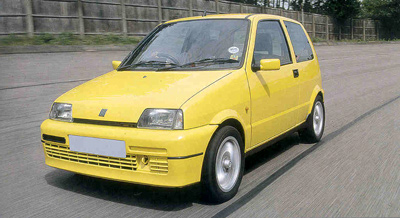
The Cinquecento, the car which brought Fiat products into the new century.
Photo courtesy Veloce Publishing.
|
�Etceterinis� a chapter devoted to coachbuilders and tuning houses, is less satisfactory since the subject is so broad it can�t be held within the confines of one chapter. Ward brings on Lombardi, Vignale, Savio, Freves, coachbuilders who actually produced a line of Fiat based cars. For the tuning houses, he includes Stanguellini , Siata , Giannini, and Moretti, again those houses which actually produced meaningful numbers of Fiat based cars. The cars of Carlo Abarth are not forgotten but incorporated into the appropriate model chapters.
Finally, Ward addresses Fiats produced outside of Italy. Poland, where Fiat has been building cars for 76 years; Germany, lest we forget the beautiful NSU Neckar Vignale Riveria; Yugoslavia, famous or infamous for the YUGO; Spain, home of the SEAT, New Zealand, where Fiat 500s were bought from Turin in kit form to be be assembled locally; and India, where you could still buy a new 1100-103D sedan into the 1990s, sold as �Premier Padminis�.
Downside: There are several silly captions, so we know that Ward was not responsible for those errors. (Ward would not make such errors). At $34.95 plus shipping, a little on the high side for a paperback. Worth it? Oh yes, and a welcome addition to our shelves.



